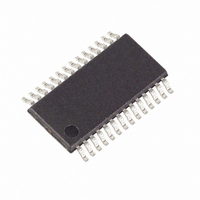MAXQ3181-RAN+ Maxim Integrated Products, MAXQ3181-RAN+ Datasheet - Page 53

MAXQ3181-RAN+
Manufacturer Part Number
MAXQ3181-RAN+
Description
IC AFE POLYPHASE LO-PWR 28-TSSOP
Manufacturer
Maxim Integrated Products
Datasheet
1.MAXQ3181-RAN.pdf
(84 pages)
Specifications of MAXQ3181-RAN+
Number Of Channels
8
Power (watts)
35mW
Voltage - Supply, Analog
3.3V
Voltage - Supply, Digital
3.3V
Package / Case
28-TSSOP
Lead Free Status / RoHS Status
Lead free / RoHS Compliant
Number Of Bits
-
again, this bit cleared. If a zero crossing on phase A is
then followed by a zero crossing on phase C, then
phase B, this bit set to 1.
The power, energy, and RMS calculation process con-
sists of two tasks: continuous accumulation and post-
processing triggered every CYCNT line cycles. The
accumulation task accumulates raw data obtained from
the AFE during CYCNT line cycles. This task is per-
formed continuously in the background by the
MAXQ3181. When a CYCNT line cycles accumulation
stage has completed, which is determined by a dedi-
cated frame counter exceeding the NS level, the raw
integral accumulator values are saved for postprocess-
ing and cleared, beginning the next cycle of accumula-
tion task. Then, the DSP postprocessing is triggered to
process saved integrals and calculate energy, power,
etc., values. Note that the background accumulation
task continues while foreground postprocessing is tak-
ing place, i.e., both tasks are executed simultaneously
sharing CPU time. It is essential that the DSP postpro-
cessing calculations be completed before the next DSP
trigger to avoid losing accumulated data. The master
should allow enough processing time by adjusting the
R_ADCRATE register. Default settings provide plenty of
CPU time for both tasks.
The MAXQ3181 accumulates raw sums and calculates
line-cycle integrals for each voltage-current pair sepa-
rately. The individual power accumulators are:
• PA = V
• PB = I
• PC = V
The PA and PC accumulators always operate in a sin-
gle mode: (V
the PC accumulator. Alternately, the operating mode of
the PB accumulator is defined by setting the
CONCFG[1:0] bits in the OPMODE1 register.
All filters have a certain settling time before accurate
energy readings can be accumulated. To avoid accu-
mulation of invalid data from filters that are still settling,
an energy accumulation timeout period can be set in
the ACC_TIMO register. When ACC_TIMO > 0, comput-
ed energy is not accumulated for ACC_TIMO of DSP
cycles. The MAXQ3181 will decrement the ACC_TIMO
register every DSP cycle until it becomes 0. When
ACC_TIMO reaches 0 value, energy accumulation
begins (or resumes, if ACC_TIMO was set to nonzero
value by the master). Pulse outputs are also disabled
(V
Power Calculation (Active and Apparent)
A
- V
B
C
A
C
)
x V
x I
x I
A
Energy Accumulation Start Delay
A
C
Low-Power, Active Energy, Polyphase AFE
B
x I
or -I
A
______________________________________________________________________________________
) for the PA accumulator, (V
B
x V
C
or -I
B
x (V
A
+ V
C
C
) or -I
x I
C
) for
B
x
when ACC_TIMO > 0. The default value of ACC_TIMO
is 0x05.
To avoid “meter creep,” no energy accumulation should
take place when measured current is less than a cer-
tain threshold. The NOLOAD register can be pro-
grammed to enable and configure this feature. If the
measured X.IRMS value for a phase (A, B, or C) falls
below the NOLOAD threshold, the energy accumulators
for this phase are not incremented. Setting NOLOAD =
0 disables this feature. Full scale is represented by
0x10000.
So far in this discussion, the values being calculated
and managed in the MAXQ3181 have been based on
fundamental units meaningful to the device itself: volt-
age as a binary fraction of full-scale voltage; current as
a binary fraction of full-scale current, and time as a non-
integer multiple of the ADC frame time.
But a practical electricity meter must report its results in
standard units, such as volts, amperes, and watts. The
MAXQ3181 contains a mechanism to convert the inter-
nal units (“meter units”) to real world units (“display
units”). This conversion is performed in the conversion
constant (CC) registers.
For some of these values (voltage, current) the calcula-
tion is simple: multiply by the conversion constant. For
other values (power, energy) the calculation is more
complex. In any case, the value in the CC register
affects only the conversion from a meter unit to a dis-
play unit; calibration is handled separately in the gain
adjustment registers for each recorded value.
The results of all on-demand calculations are reported
as 8-byte (64-bit) values of which no more than 6 bytes
(48 bits) are significant. Eight bytes are used as a com-
mon length; however, fewer bytes can be requested for
those registers known to have smaller maximum values.
For example, the power factor virtual register has a
maximum value that is expressed in only 3 bytes; con-
sequently, the register can be requested with a length
of 4 bytes without loss of data.
These registers (V.A, V.B, V.C, I.A, I.B, I.C) are calculat-
ed by simply multiplying the calculated RMS value
(A.VRMS, B.VRMS, C.VRMS, A.IRMS, B.IRMS, C.IRMS)
by the contents of the VOLT_CC or AMP_CC register.
Since the RMS voltage and RMS current are given in 32-
bit registers and the conversion coefficients are given in
16-bit registers, the result of the product is 48 bits.
On Demand Calculations
RMS Volts, RMS Amps
No-Load Feature
53











